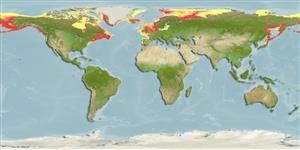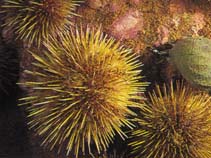Strongylocentrotus droebachiensis (Müller, 1776)
Northern sea urchin| Native range | All suitable habitat | Point map | Year 2050 |

|
| This map was computer-generated and has not yet been reviewed. |
| Strongylocentrotus droebachiensis AquaMaps Data sources: GBIF OBIS |
Classification / Names Common names | Synonyms | CoL | ITIS | WoRMS
Echinoidea | Camarodonta | Strongylocentrotidae
Environment: milieu / climate zone / depth range / distribution range Ecology
Benthic; depth range 0 - 300 m (Ref. 78719), usually 0 - 50 m (Ref. 113749). Temperate; 79°N - 37°N, 127°E - 97°E
Distribution Countries | FAO areas | Ecosystems | Occurrences | Introductions
Northern Pacific, Northern Atlantic and the Arctic. Temperate to polar.
Length at first maturity / Size / Weight / Age
Maturity: Lm 2.5 range ? - ? cm Max length : 10.0 cm WD male/unsexed; (Ref. 865); max. reported age: 45 years (Ref. 90469)
It is found on rocks and soft bottoms from the intertidal to a depth of 300 meters (Ref. 865). Also in tidepools in the low intertidal, found on bedrock outcrops, boulders, cobbles, occasionally in sand (Ref. 113749). Primarily feeds on seaweeds, with few feeding on eelgrass (Ref. 106946). Also feeds on bivalves, gastropods and benthic crustaceans (Ref. 85579).
Life cycle and mating behavior Maturity | Reproduction | Spawning | Eggs | Fecundity | Larvae
Members of the class Echinoidea are gonochoric. Fertilization is external. Brooding is common, eggs are held either on the peristome, around the periproct or deep into the concavities on the petaloids. Life cycle: Embryos develop into planktotrophic larvae (echinoplateus) and live for several months before they sink to the bottom using their tube feet to adhere on the ground where they metamorphose into young urchins.
Main reference
References | Coordinator | Collaborators
Berkes, F., T.P. Hughes, R.S. Steneck, J.A. Wilson, D.R. Bellwood, B. Crona, C. Folke, L.H. Gunderson, H.M. Leslie, J. Norberg, M. Nyström, P. Olsson, H. Österblom, M. Scheffer and B. Worm. 2006. (Ref. 861)
IUCN Red List Status (Ref. 130435)
CITES status (Ref. 108899)
Not Evaluated
CMS (Ref. 116361)
Not Evaluated
Threat to humans
Human uses
Fisheries: commercial
| FishSource | Sea Around Us
Tools
More information
Internet sources
BHL | BOLD Systems | CISTI | DiscoverLife | FAO(Publication : search) | Fishipedia | GenBank (genome, nucleotide) | GloBI | Gomexsi | Google Books | Google Scholar | Google | PubMed | Tree of Life | Wikipedia (Go, Search) | Zoological Record
Estimates based on models
Preferred temperature
(Ref. 115969): 0.8 - 10.2, mean 5.2 (based on 977 cells).
Resilience
(Ref. 69278):
High, minimum population doubling time less than 15 months (K=0.12-0.84; tm=2.5; tmax=45).
Nutrients: Calcium = 126 [75, 177] mg/100g; Iron = 5.08 [1.67, 7.92] mg/100g; Protein = 12%; Omega3 = 0.331 [0.263, 0.400] g/100g; Selenium = 0.04 [48.48, 67.17] μg/100g; VitaminA = 0 μg/100g; Zinc = 1.97 [0.92, 3.02] mg/100g (wet weight).



